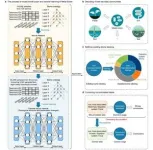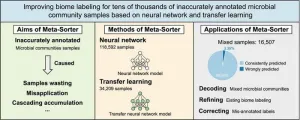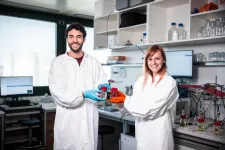(Press-News.org) Scientific research depends on collaboration between researchers and institutions. But over the past decade, there has been a surge of large-scale research projects involving extraordinarily large numbers of researchers, from dozens to hundreds, all working on a common project. Examples of this trend include ManyBabies, centred on infant cognition and development, and ManyManys, focused on comparative cognition and behaviour across animal taxa. These kinds of projects, known as big team science (BTS), benefit from pooled human and material resources and draw on diverse data sets to gird studies with a robustness not found in smaller ones.
However, as exciting as these projects can be, they can also be monsters to manage. Communication, team building, governance, authorship and credit are just some of the issues BTS team leaders must negotiate, along with the logistical difficulties involved in working across languages, cultures and time zones.
Fortunately, a group of BTS veterans, including two Concordia researchers, has published a how-to guide to help their fellow academics build their own projects. The article, published in the Royal Society Open Science journal, is based on expertise gained over multiple BTS projects, and it provides a road map for best practices and overcoming challenges.
“BTS is a new way of conducting research where many researchers come together to answer a common question that is crucial to their field,” says Nicolás Alessandroni, a postdoctoral fellow at Concordia’s Infant Research Lab. Alessandroni works under the direction of Krista Byers-Heinlein, a professor of psychology and the Concordia University Research Chair in Bilingualism and Open Science. The two co-authored the article with researchers at Stanford University, the University of British Columbia and the University of Manitoba.
“This is important because research has traditionally been conducted in a siloed manner, where individual teams from one institution work with small, limited samples.”
Building up step by step
The authors acknowledge that no two projects are alike, and there is no one model to creating a BTS study. But success can be achieved by applying a common approach.
They suggest starting by identifying whether a research community believes the project is necessary. Consensus buy-in gets things rolling.
Once a project is a go, the authors outline how team leaders can work together to share data and collaborate on writing. The guide is designed to provide a path forward for researchers and to smooth over differences that are almost inevitable when the number of collaborators reaches three or even four digits. It touches on topics ranging from governance and codes of ethics to designated writing teams and authorship protocols.
“The beauty of big team science is that anyone can join, from undergraduates to faculty,” says Alessandroni. “There are all these different experiences that coalesce around BTS, and this provides an opportunity to integrate many perspectives into a project. You can have some people who are very seasoned researchers and others who are young students willing to collaborate and embrace this new way of doing science.”
Open to all
He admits that BTS projects are not easy to manage, but they do have clear strengths and benefits.
“Its very definition relates to important values in science: transparency, collaboration, accessibility, equity, diversity and inclusion — it touches on many important topics that have been disregarded in the practice of science traditionally. In many ways, it overlaps with the concept of open science, where data is shared openly and publications are available in open-access journals and repositories, making knowledge available without charging readers.”
Alessandroni notes that universities will have to adapt to accommodate changes in the way research is supported.
“Institutions worldwide can help foster BTS collaborations by devising new workflows, policies and incentive structures,” he says. “Naturally, this would involve important changes to the academic ecosystem, so there is much to discuss.”
Read the cited paper: “How to build up big team science: a practical guide to large-scale collaborations.”
END
A guide to Big Team Science creates a blueprint for research collaboration on a large scale
Postdoc Nicolás Alessandroni and Professor Krista Byers-Heinlein co-author a how-to paper on managing BTS research projects
2023-09-08
ELSE PRESS RELEASES FROM THIS DATE:
Penn Medicine research uncovers brain-blood barrier's role in governing ant behavior
2023-09-08
PHILADELPHIA— The blood-brain barrier (BBB) has been found to play a significant role in controlling behavior critical to how ant colonies function, according to new research from the Perelman School of Medicine at the University of Pennsylvania. The implications of this research on the intricate mechanisms behind ant behavior go beyond the world of ants. The findings, published this week in Cell, hint at similar mechanisms at play in other species, including mammals.
In ants, along with other animals, the BBB consists of tightly locked cells that protect the brain from germs and other harmful substances. The protective barrier plays a key role in how the brain and ...
Using smart bioelectronic devices to capture and release tumor cells
2023-09-08
Metastasis is the leading cause of death in cancer, occurring when a cell leaves the primary tumour, passes into the bloodstream and lymphatic system and reaches distant organs. Non-invasive collection of these circulating tumour cells is essential for the study of cell biology, the diagnosis and prognosis in cancer research, and drug development. As a general rule, the concentration of cancer cells found in blood is very small with respect to other cell types, and traditional methods of collecting them in a viable way are laborious.
“We wanted to come up with a device capable ...
Obstetrics & Gynecology devotes special issue to addressing racism in reproductive health
2023-09-08
September 8, 2023 — As part of its active efforts to dismantle systemic racism and promote principles of equity and inclusion within its editorial processes and content, Obstetrics & Gynecology, the official journal of the American College of Obstetricians and Gynecologists, has devoted its entire October 2023 issue to addressing racism in reproductive health. The journal is published in the Lippincott portfolio by Wolters Kluwer.
A journal with such a rich history must root out inequity
"Let ...
Valleytronics is warming up at Brookhaven Lab
2023-09-08
UPTON, NY—Researchers at the Center for Functional Nanomaterials (CFN), a U.S. Department of Energy (DOE) Office of Science User Facility at DOE’s Brookhaven National Laboratory, and Northrop Grumman, a multinational aerospace and defense technology company, have found a way to maintain valley polarization at room temperature using novel materials and techniques. This discovery could lead to devices that store and process information in novel ways using this technology without the need to keep them at ultra-low temperatures. Their ...
Refining biome labeling for microbial community samples: AI approach unravels hidden
2023-09-08
In a groundbreaking study published on July 26, 2023, in the journal Environmental Science and Ecotechnology, researchers from Huazhong University of Science and Technology have introduced "Meta-Sorter," an AI-based method that leverages neural networks and transfer learning to significantly improve biome labeling for thousands of microbiome samples in the MGnify database, especially those with incomplete information. The Meta-Sorter approach comprises two crucial steps. Firstly, a neural network model is meticulously constructed using 118,592 microbial samples from 134 biomes and their respective biome ontology, boasting an impressive average ...
Exercise-induced hormone irisin may reduce Alzheimer’s disease plaque and tangle pathology in the brain
2023-09-08
BOSTON – Researchers who previously developed the first 3D human cell culture models of Alzheimer’s disease (AD) that displays two major hallmarks of the condition—the generation of amyloid beta deposits followed by tau tangles—have now used their model to investigate whether the exercise-induced muscle hormone irisin affects amyloid beta pathology.
As reported in the journal Neuron, the Massachusetts General Hospital (MGH)–led team has uncovered promising results suggesting that irisin-based ...
Immunogenicity and reactogenicity of co-administration of COVID-19 and influenza vaccines
2023-09-08
About The Study: In this study of health care workers who received a COVID-19 vaccine, an influenza vaccine, or both, co-administration was not associated with substantially inferior immune response or to more frequent adverse events compared with COVID-19 vaccine administration alone, supporting the co-administration of these vaccines.
Authors: Gili Regev-Yochay, M.D., of the Sheba Medical Center in Ramat Gan, Israel, is the corresponding author.
To access the embargoed study: Visit our For The Media website at this link https://media.jamanetwork.com/
(doi:10.1001/jamanetworkopen.2023.32813)
Editor’s ...
Readmission rates after acute respiratory distress syndrome in children
2023-09-08
About The Study: The findings of this study suggest that childhood survivors of acute respiratory distress syndrome (ARDS) are at high risk of readmission in the first two months after discharge. Future studies should evaluate whether post-discharge interventions (e.g., telephonic contact, follow-up clinics, and home health care) may help reduce the readmission burden.
Authors: Garrett Keim, M.D., of Children’s Hospital of Philadelphia, is the corresponding author.
To access the embargoed study: Visit our For The Media website at this link https://media.jamanetwork.com/
(doi:10.1001/jamanetworkopen.2023.30774)
Editor’s ...
Ballet of the brain: Unlocking the choreography of movement
2023-09-08
The zebrafish brain, though simpler than its human counterpart, is a complex network of neurons that engage in a ceaseless dance of electrical activity. What if this neural ballet could reveal the secrets of how brains, including our own, control movement? A zebrafish study led by researchers at the Champalimaud Foundation offers a new lens through which to view the activity of neural populations, and to understand how the brain orchestrates motion.
Why we have a brain
“The brain’s primary function is movement”, explains Claudia Feierstein, lead author of the study ...
Bacteria generate electricity from wastewater
2023-09-08
“We engineered E. coli bacteria, the most widely studied microbe, to generate electricity,” says Professor Ardemis Boghossian at EPFL. “Though there are exotic microbes that naturally produce electricity, they can only do so in the presence of specific chemicals. E. coli can grow on a wide range of sources, which allowed us to produce electricity in a wide range of environments, including from waste water.”
In a paper published in the journal Joule, Boghossian’s team report a groundbreaking achievement in bioelectronics, advancing the capabilities of common E. coli bacteria to generate ...
LAST 30 PRESS RELEASES:
SwRI upgrades nuclear magnetic resonance laboratory for pharmaceutical R&D
House sparrows in northern Norway can help us save other endangered animals
Crohn's & Colitis Foundation survey reveals more than 1/3 of young adults with IBD face step therapy insurance barriers
Tethered UAV autonomous knotting on environmental structures for transport
Decentralized social media platforms unlock authentic consumer feedback
American Pediatric Society announces Vanderbilt University School of Medicine as host institution for APS Howland Visiting Professor Program
Scientists discover first method to safely back up quantum information
A role for orange pigments in birds and human redheads
Pathways to net-zero greenhouse gas emissions for Southeast Asia
A JBNU–KIMS collaborative study on a cost-effective alloy matches superalloys for power plants and energy infrastructure
New study overturns long-held model of how plants coordinate immune responses.
New AI model predicts disease risk while you sleep
Scientists discover molecular ‘reshuffle’ and crack an 80-year-old conundrum
How stressors during pregnancy impact the developing fetal brain
Electrons lag behind the nucleus
From fungi to brain cells: one scientist's winding path reveals how epigenomics shapes neural destiny
Schizophrenia and osteoporosis share 195 genetic loci, highlighting unexpected biological bridges between brain and bone
Schizophrenia-linked genetic variant renders key brain receptor completely unresponsive to both natural and therapeutic compounds
Innovative review reveals overlooked complexity in cellular energy sensor's dual roles in Alzheimer's disease
Autism research reframed: Why heterogeneity is the data, not the noise
Brazil's genetic treasure trove: supercentenarians reveal secrets of extreme human longevity
The (metabolic) cost of life
CFRI special issue call for papers: New Frontiers in Sustainable Finance
HKU Engineering scholar demonstrates the smallest all-printed infrared photodetectors to date
Precision empowerment for brain "eavesdropping": CAS team develops triple-electrode integrated functional electrode for simultaneous monitoring of neural signals and chemical transmitters during sleep
Single-capillary endothelial dysfunction resolved by optoacoustic mesoscopy
HKU three research projects named among ‘Top 10 Innovation & Technology News in Hong Kong 2025’ showcasing excellence in research and technology transfer
NLRSeek: A reannotation-based pipeline for mining missing NLR genes in sequenced genomes
A strand and whole genome duplication–aware collinear gene identification tool
Light storage in light cages: A revolutionary approach to on-chip quantum memories
[Press-News.org] A guide to Big Team Science creates a blueprint for research collaboration on a large scalePostdoc Nicolás Alessandroni and Professor Krista Byers-Heinlein co-author a how-to paper on managing BTS research projects





